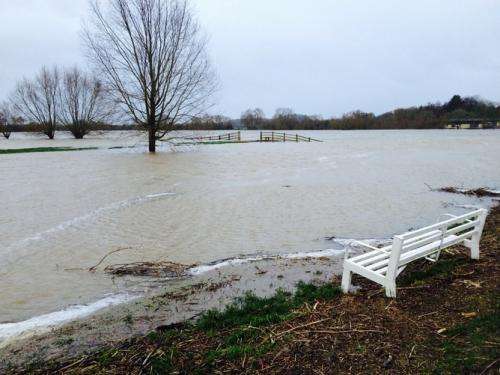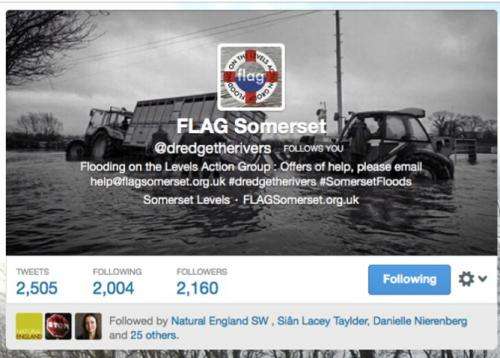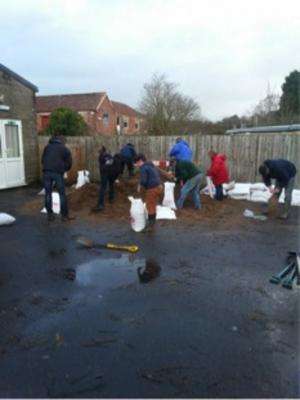While UK ministers dither on floods, social media springs into action

I've just returned from sandbagging near the swollen River Parrett at Langport, a town next to the flooded Somerset Levels. There, local people are using new media to take action in the midst of a disaster.
The flooding has been going on since before Christmas and is now reaching crisis point. An area of 65km2 around the Muchelney and Moorland is underwater, covering farms and affecting 150 homes. Isolated properties, hamlets and whole villages now find themselves flooded, roads are closed and services disrupted, potentially for the forseeable future.
Relations between government ministers and the Environment Agency have soured over the lack of support on offer to the victims of the floods. So while they argue, locals are using social media to help themselves.
A group called Flooding on the Levels Action Group, or FLAG Somerset, has emerged to coordinate activities on the ground, using Twitter to lead an extraordinarily effective community response.
FLAG, which began life as a local pro-dredging pressure group, has been active on Twitter since early January. By 25 January, it had 300 followers and it now has more than 2,000. The feed is used to inform local residents about what is happening and to collect pledges of support from the outside world.
The group posts pictures of what is happening on the ground, such as photos of an HGV loaded with straw heading off from Rutland and locals sandbagging together. It also charted the arrival of the Khalsa Aid group, a British-based international relief organisation which helped desperate householders move furniture upstairs and make sandbags.

Over on Facebook, FLAG's action group has grown enormously with 5,958 new members. The co-ordination group has been running for less than a week but already has an office and laptops for volunteers to channel offers of help and often urgent calls for assistance.
The Facebook action group was used to call for volunteers to help create a secure riverside path for villagers of Burrowbridge, whose roads are all flooded. Some volunteers came to the scene after work to pitch in while others offered food to help keep them going. As a result, an impressive path was created out of piles of wood chip along one side of the river. It is the only way for some villagers to access emergency supplies stored at the local pub.
Returning to the warm and dry, I'm hooked on watching the apparently endless support pouring in from around the county and beyond on the FLAG Facebook page. There are rest centres for people flooded out of their homes, drop-off points across the county for supplies to be donated to those in need and information about where to find them is all online. Blankets, food, clothing and toiletries are pouring in after online appeals and charities such as PetAid have donated pet food. Perhaps most importantly of all, tonnes of sand, sand bags and Dutch pumps are being pledged and delivered.
Donations are just one side of the story though. FLAG's Twitter and Facebook accounts are used to send out appeals for help and requests for donations, using a variety of hashtags. Tweets asking for any spare waders to be sent to a certain location in the area, appear to be particularly common, for example.
The social media pages run by FLAG have become the go-to community resource for help as more and more houses and farms have been overwhelmed. FLAG will post a shout out on its Facebook page and, very quickly, people pull on their wellies and head out to help. It has led to livestock being moved to safer locations and sandbags being distributed to where they are most needed. Now the group has organised a central list of contacts and emergency numbers to help with communications.
These activities, widely shared through Facebook and Twitter, are going unreported as the mass media focuses on high-level visits and the endless debate about how best to manage landscapes that are vulnerable to flooding. What these communities really do not appreciate is talk pronouncing their demise. Those who have not been here to see the people digging in to support not only each other, but also the continuation of their communities, have not seen the full picture of this flooding disaster story.

Through FLAG this inundated area of Somerset is drawing in grassroots knowledge to respond to reports from experts, as well as unappreciated comments from others.
The group has come up with a seven-point plan for dealing with floods in the future. This plan acknowledges the complexity of managing a low-lying area such as the Levels and not only calls for dredging and a tidal barrage on the River Parrett, but also points to the importance of increasing infiltration and creating attenuation ponds upstream.
In using social media, the people working together in Somerset have shown enormous community resilience and demonstrated how online tools can be used to make a fast response to a changing situation possible.
But it should also be said that this response is taking people out of their everyday lives. Community ties are being strengthened through this disaster but some lives are on hold and others are being ripped apart by the flooding.
Source: The Conversation
This story is published courtesy of The Conversation (under Creative Commons-Attribution/No derivatives).
![]()




















